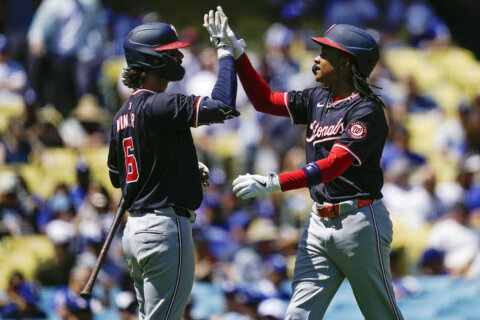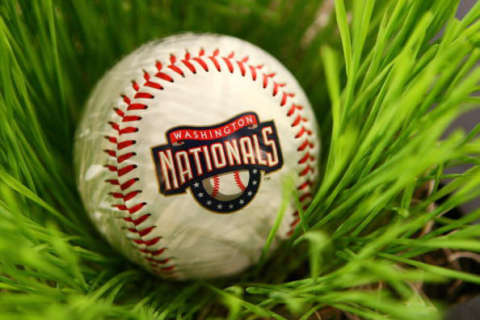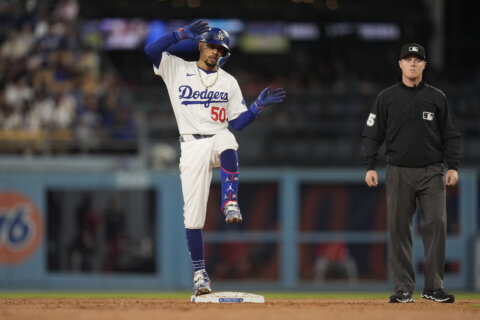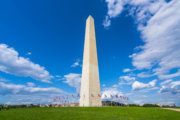By the time the Nationals host the New York Yankees in Thursday’s season opener, 267 days will have passed since they last played a meaningful baseball game. You may remember that one.
In the nearly nine months since, there’s been: A championship parade, Spring Training, a global pandemic, bickering between owners and players, a virtual ring ceremony, more bickering between owners and players, another Spring Training (Summer Camp, if you prefer), socially distanced workouts and exhibition games played in empty stadiums.
There have also been plenty of questions.
Finally on Thursday, we may start to get some answers. We’ll also get an actual game that counts in the standings. Fifty-nine more will follow in what will amount to the shortest season since 1878.
“You’re pretty much starting in a playoff run,” Nationals manager Dave Martinez said.
Much of the abbreviated 2020 campaign will look and feel like nothing Major League Baseball has produced before.
“It’s definitely outside-the-box,” Nationals outfielder Adam Eaton said. “It’s definitely not the norm. I think all of our bodies are like, ‘What in the world is going on?’”
From the urgency that will accompany the shortened season, to piped-in crowd noise, to regionalized scheduling to new rules like the universal designated hitter, there is a curiosity factor to see how it all plays out.
Of course, there’s also the matter of navigating through a season complete with coronavirus testing and expanded health protocols.
Below are several storylines to follow as the Nationals begin their World Series defense in earnest.
Empty stadiums and piped-in crowd noise
One of the biggest oddities this year will be watching or listening to games played in cavernous empty stadiums. While some teams hope to welcome a limited number of fans to their ballparks later this summer, the season will begin without any live crowds.
The only other time MLB staged a regular-season game without fans was in 2015 when civil unrest in Baltimore forced the Orioles and White Sox to play behind closed doors at Camden Yards.
“I did not enjoy it,” outfielder Eaton said, the White Sox leadoff hitter that afternoon. “Just the energy and the feel. The game is completely different [without fans].”

MLB and its clubs have been experimenting with different elements such as piped-in crowd noise and the continued use of walk-up music and PA announcements to help simulate the game-day ballpark experience.
“I think any noise will help,” Eaton said. “Even if you have that buzz in the stadium, I think it will help.”
Nationals’ pitcher Erick Fedde agrees.
“If anything, maybe it helps zone you in a little more when you get that little extra bit of adrenaline for a big moment,” Fedde said.
For fans who plan to listen or watch games with piped-in crowd noise, here’s an initial thought: The crowd noise translates well on radio. The constant murmur/buzz between pitches gives the broadcast a ‘normal’ sound. On television, it may take some getting used to. The crowd noise is a tougher sell on TV when the viewer can’t help but notice all the empty seats or cardboard cutouts.
Testing and health protocols
A live crowd won’t be the only ballpark fixture missing in 2020.
In an attempt to limit health risks, several game-day rituals — some archaic, others more habitual — will also be discouraged or outright forbidden this season.
Spitting, consuming sunflower seeds, licking one’s fingers (to help better grip the baseball) and celebratory contact like high fives or hugs are all prohibited in 2020.
During the first few days of summer camp, several players and staff members acknowledged that eliminating these often subconscious actions from their daily routines wasn’t easy.
“I’ve had to catch myself a couple of times trying not to spit out there,” Nationals rookie third baseman Carter Kieboom said. “It’s just a habit. It’s something baseball players have done their entire lives.”

Some players have suggested that wearing a mask has helped deter them from spitting. Mask wearing isn’t mandatory for players during games, but all non-players in the dugout or bullpen areas must wear them. A handful of players, including the Yankees’ Clint Frazier, the Phillies’ Didi Gregorious and the Nationals’ Wilmer Difo, have chosen to wear masks while playing.
While expanded rosters can include up to 30 players for the first two weeks of the season, the dugouts will actually be less congested than usual. Inactive players will sit six feet apart in auxiliary dugouts (tents) located either in the stands or in the camera well.
Social distancing will be practiced when possible with the league discouraging opposing players from interacting with each other before or after games.
Even team bus rides could feel different. When the Nationals drove up to Baltimore for an exhibition game this week, they loaded five buses with 14 passengers each. Typically the traveling party would only require two buses to carry the entire group.
Testing for the coronavirus pandemic will also be performed every other day throughout the season. Players testing positive must quarantine for two weeks and then must be free of symptoms and test negative twice before rejoining their clubs.
After initial challenges with the turnaround for test results, the consensus around MLB is that results have come back within the promised 48-hour window.
The regionalized schedule and the 60-game sprint
In an attempt to limit travel this season, MLB and the Players Association agreed that teams would only play opponents from within their own division and from their regional interleague counterpart.
In the Nationals case, that means 40 games against teams in the National League East and 20 games against teams in the American League East.
Click here for the complete Nationals 2020 schedule.
It’s hard to predict how some of the geographic and traditional rivalries will translate without fans in attendance, but the favorable travel should be welcome in a season that will otherwise be chock-full of hurdles.
While the travel will be relatively easy, the itinerary itself could pose a challenge for the Nationals. Yes, they get 16 games, or nearly 27% of their schedule, against the lowly Miami Marlins (10x) and Baltimore Orioles (6x), but 40 of their 60 games will be against teams that finished last season above .500.

The 60-game schedule also provides added weight to each contest. Compared to the usual 162-game marathon, every game this season will count 2.7 times more than usual.
Whereas teams can typically work their way out of extended lulls over the course of the six-month grind of a regular-season, this year’s nine-week sprint offers no such luxury.
As great of a story as the Nationals in-season turnaround was last year, the 2020 schedule simply doesn’t provide enough racetrack to overcome a shaky start.
“We know it’s going to be a short season,” said Nationals catcher Yan Gomes. “We can’t really do the whole 19-31 and make it a story again.”
What can Stephen Strasburg do for an encore
Max Scherzer will be the Nationals’ Opening Day starter Thursday for the fifth time in the last six years. While Scherzer remains atop the Nationals pitching depth chart, a case could be made that Stephen Strasburg may be Washington’s most important pitcher.
As Scherzer battled neck and back issues last year, Strasburg emerged as Washington’s workhorse. Years after having his own durability questioned, Strasburg led the National League in innings pitched (209) and wins (18). Both were personal bests, as were his 251 strikeouts.
It was all the prelude to a dominant postseason in which Strasburg went 5-0 with a 1.98 ERA and was ultimately handed the keys to a Corvette C8 as World Series MVP.

Given the increased workload and the high-leverage innings he threw last fall, perhaps an abbreviated 2020 season will work to Strasburg’s advantage. Can he pick up where he left off in the 12 starts he’ll potentially make this regular season?
There’s no reason to doubt it. With a new seven-year $245 million contract in tow, Strasburg is now the Nationals highest paid pitcher. With Ryan Zimmerman opting out of the 2020 season, Strasburg is also the longest tenured National on the roster.
It’s been more than 10 years since Strasburg burst onto the scene as the generational prospect who amazed with a 14-strikeout debut. Watching the 21-year-old rookie baffle veterans while consistently throwing in the upper 90s was fun to watch.
A decade later, though, Strasburg is suddenly a veteran himself. Watching him adapt and mature as he hits the back nine of his career is also proving an easy watch.
While Strasburg’s velocity isn’t what it once was, his change-up remains among the game’s best. Strasburg, who turned 32 this week, continues to evolve as a pitcher rather than just a thrower. According to Baseball Savant, Strasburg relied on his change-up more last season (20.7 percent) than at any prior point in his 11-year career.
With questions still surrounding the Nationals bullpen (an annual tradition in these parts), manager Dave Martinez could lean heavily on the men he describes as his four horses. In Scherzer, Strasburg, Patrick Corbin and Anibal Sanchez, the top of the Nationals rotation is stacked again.
But if the Nationals are to again play deep into October, much will rest on how much heavy lifting they get from Strasburg.
Who emerges as the Nationals’ fifth starter
While the Nationals will lean on their core four atop the rotation, that still leaves about 11-12 outings that will need to be filled by a fifth starter.
The decision by Joe Ross to opt out of the 2020 season essentially made it a two-man summer camp competition between Erick Fedde and Austin Voth for the No. 5 spot.

Both righties impressed at camp and both had a taste of the rotation in 2019.
Fedde, 27, made 12 starts last season, going 4-2 over that stretch with a 4.48 ERA in 60 1/3 innings.
Voth, 28, made eight starts last year, going 2-1 in those appearances with a 3.48 ERA in 41 1/3 innings.
While the cameo appearances in the rotation provide some experience, neither Fedde (26 starts across three seasons) or Voth (10 starts over parts of two seasons) have been able to grab hold of the No. 5 spot and take ownership of it for more than a few weeks at a time.

Both view 2020 as an opportunity to earn a spot in the rotation and keep it.
“I’ve been preparing for this role the whole offseason,” said Voth. “I haven’t stopped preparing for it. I’m ready if I get the role. It’s something that I’m ready for. I’m ready to take it on.”
In all likelihood, both Fedde and Voth will be relied upon in some capacity. One will be the No. 5 starter while the other will likely serve as Washington’s long man out of the bullpen. Given the truncated schedule (60 games in 66 days) and the lack of mutual off days with opponents, there could also be a handful of doubleheaders which would call for an emergency starter.
Filling the void left at third base
On the field, perhaps the biggest challenge facing the Nationals is how they’ll replace third baseman Anthony Rendon.
In a perfect world, prospect Carter Kieboom would seamlessly transition to the hot corner and the baton would be passed. In early July, manager Dave Martinez came out and said the job was Kieboom’s to lose.
“In a 60-game season, he’s going to go out there and play every day,” Martinez said on July 4.
Two weeks later, Martinez played it more conservatively suggesting Kieboom, 22, would split time with veteran Asdrubal Cabrera.
“Both of those guys are going to play third, they know that,” Martinez said on July 18. “We definitely want to play Cabby as well … Cabby’s going to play third, he’s going to play second, he’s going to play some first, possibly DH. When we start up, we’ll see where we’re at.”

The long-range forecast calls for Kieboom, the organization’s No. 1 rated prospect. The short-term view is more complicated.
The urgency that will accompany each game during the shortened season doesn’t lend itself to developing a rookie, dealing with the inevitable early-season growing pains and hoping to reap the benefits by the second half of the year.
Given Kieboom’s limited Major League experience (he hit .128 during an 11-game call-up last year as a shortstop) and given his limited experience as a third baseman (a total of 10 Minor League games at the position), a reliable switch-hitting veteran like Cabrera offers a pretty good security blanket.







